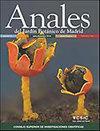南美凤梨属的分类修正(凤梨科,凤梨科)
IF 0.7
4区 生物学
Q4 PLANT SCIENCES
引用次数: 1
摘要
Mulinum属是南美洲南部特有的,由于其在安第斯山脉和巴塔哥尼亚大草原的植被中占主导地位,因此具有重要的生态意义。我们提出了一种处理方法,其中10种和3个新变种被接受。本文提供了该物种的诊断关键字,并提供了同义词列表、形态描述、种间形态相似性观察、相关文献综述、插图和分布图。我们还分析和解决命名问题,并提供可疑名称和排除名称的列表。六个新的同义词被确认,包括M. axilliflorum和M. echinus。此处认为Mulinum famatinense是三棘菌的一个变种。另外两个已确认的品种是毛棘棘和泽棘棘。石竹、细棘、棘、三棘和毛棘的分布范围有所扩大。此外,还指定了27种类型和1种新类型。本文章由计算机程序翻译,如有差异,请以英文原文为准。
Taxonomic revision of the South American genus Mulinum (Azorelloideae, Apiaceae)
The genus Mulinum is endemic to southern South America and is ecologically important because of its dominance in the vegetation of the high Andes and the Patagonian steppe. We present a treatment in which 10 species and 3 new varieties are accepted. A diagnostic key to the species is included, and lists of synonyms, morphological descriptions, observations on the morphological affinities between species, review of the relevant literature, illustrations, and distribution maps are provided. We also analyze and resolve nomenclatural problems, and we provide a list of dubious names and excluded names. Six new synonyms are recognized, including the names M. axilliflorum and M. echinus. Mulinum famatinense is considered here a variety of M. triacanthum . The other two varieties recognized are M. spinosum var. hirsutum and M. spinosum var. zechii . The area of distribution for M. crassifolium, M. leptacanthum, M. spinosum, M. triacanthum, and M. ulicinum has been extended. In addition, 27 lectotypes and one neotype are designated.
求助全文
通过发布文献求助,成功后即可免费获取论文全文。
去求助
来源期刊

Anales Del Jardin Botanico De Madrid
PLANT SCIENCES-
CiteScore
1.20
自引率
0.00%
发文量
9
审稿时长
>12 weeks
期刊介绍:
Anales del Jardín Botánico de Madrid features original and unpublished articles in fields such as taxonomy and systematics of all plant groups and fungi, including related fields like biogeography, bioinformatics, conservation, ecophysiology, phylogeny, phylogeography, functional morphology, nomenclature and plant-animal relations, as well as reviews and summary works. Anales del Jardín Botánico de Madrid is published half-yearly, with two issues appearing in June and December.
 求助内容:
求助内容: 应助结果提醒方式:
应助结果提醒方式:


